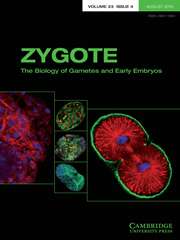No CrossRef data available.
Article contents
Effects of different temperatures on the embryonic development of the Lebranche mullet Mugil liza
Published online by Cambridge University Press: 19 September 2024
Summary
We herein investigated the influence of temperature on the embryonic development (from fertilisation to hatching) of Mugil liza larvae. For this purpose, oocytes (>600 μm) and sperm were obtained from breeding stock at the laboratory of marine fish culture (LAPMAR). After fertilisation, 1200 eggs were distributed in 12 cylindrical experimental units of 400 mL under four different temperatures 18, 22, 26 and 30 ºC, all in triplicate. Every 15 min until hatching, about 10 eggs were randomly sampled in each treatment. The eggs were visualized and photographed, and the classification of embryonic stages was performed. Temperature influenced the main events of the embryonic development of M. liza. More accelerated development was observed according to the increase in temperature until the gastrula phase. At temperatures of 22 and 26 °C, embryonic development occurred from fertilisation to hatching of the larvae. In the 18 °C treatment, it was verified that most of the embryos ceased development during the final phase of cleavage and the beginning of blastula formation, while in the 30 °C treatment patterns of embryo malformation were also verified, with erratic divisions of the blastomeres, resulting in irregular cells. Unlike what was observed at a temperature of 18 °C, none of the embryos incubated at 30 °C reached the blastopore closure phase, stopping in the gastrula. The larvae hatched in the treatments at 22 and 26 °C were viable and exhibited intense swimming, with a large amount of reserve material (yolk) and an evident drop of oil.
- Type
- Research Article
- Information
- Copyright
- © The Author(s), 2024. Published by Cambridge University Press



